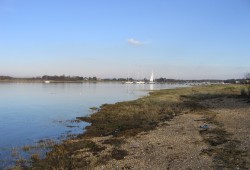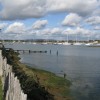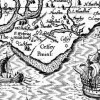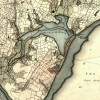Chichester Harbour Events Nov 2021

| 50th Anniversary Chichester Harbour Conservancy 1971 – 2021 |
| What’s On?
The full list of guided walks and activities until the end of March 2022 can be seen here. The solar-powered boat, Solar Heritage, is operating bird watching trips throughout the winter season. For the schedule and to book see here. Every birding event is led by a bird watching enthusiast. Upcoming talks organised by the charity Friends of Chichester Harbour will be advertised on their website, for membership details and to see what’s on, see here. Christmas gift ideas from the Conservancy Thinking of what to buy your family and friends this Christmas – why not choose from the following? New! A pack of walks and cycle routes in the Chichester Harbour area is now available to buy from our Harbour Office. The 12 walks, 3 cycle routes and 7 easy access routes are all on sturdy, full colour A4 sheets with route information, maps, directions and photos. The pack costs £12 and includes a clear popper storage wallet. Vouchers for Solar Heritage boat trips can be bought from the Harbour Office at Itchenor. Call in or phone 01243 513275. The schedule of sailing trips for the 2022 season on board Oysterboat Terror will be published soon on her dedicated website, see here. Terror can take up to 6 paying passengers; choose from either single tickets or full boat charters. Once the schedule is published you can book a trip up front for next season. Photo Workshop - Saturday 22 January 2022 The Final Duck Race Saturday 26 March 2022 Publication: Exploring the Geology of Chichester Harbour by David Bone (2019) £4.50 from the Harbour Office |
| 50 years of the Conservancy Part 11: Lifelong LearningUnderstanding the natural world is quite possibly the best example of the old saying ‘the more you know, the more you realise you don’t know’! Chichester Harbour is an area of great beauty, a wide variety of habitats and a wealth of wildlife. So much to learn about! At times, though, it can also be very full of people….Back in 1971 when the Conservancy was formed by Act of Parliament, one of its new responsibilities was to help people learn and understand more about the Harbour so that we could all to do our bit to help look after it. The new Director and Harbourmaster, Ian MacKay, introduced a regular newsletter, for everyone, not just boating people but also for local residents and visitors. The Harbour News was first published in December 1974. These days we have the annual Information for Mariners booklet and the seasonal issues of Harbour Life. In the 1970s a volunteer, Joan Edom, agreed to be the first conservation warden for the Conservancy, though at this time it was just a voluntary role. Joan was instrumental in getting Nutbourne Marshes designated a local nature reserve in 1976. Another lasting legacy was the regular winter-season bird watching walks that Joan set up for nearly every Sunday from mid-November to mid-February each winter until her retirement in 1987. Joan retired once a salaried post had been established and this was held by James Fennell for and she kept up the tradition of the regular Sunday walks at Nutbourne for many years. In 1996 I (Judi) joined the AONB team as Education and Interpretation Warden, initially to answer ‘Dear Harbourmaster’ letters from school pupils working on their school projects. It involved a lot of photocopying as this was in the days before most people had computers and the internet was just a very new idea. Not long after I started work I decided that it would be better if I got out and about in the AONB to meet people and talk about the Harbour area. Very soon the year-round walks and activities programme was established which has continued to this day, well, apart from the Covid Lockdown era when I spent a lot more time working on projects at a desk. The long-standing bird walks that Joan established have these days been largely replaced by regular bird watching trips on the Solar Heritage. There is a birding enthusiast on every one to help identify what we see. One bird watching walk at Nutbourne is still led each year in memory of Joan Edom. This year it will be at 8am on Sunday 21 November, see here for details and to book. Another one is planned for World Wetlands Day on 2 February, see here, and this one will be at West Wittering. Alongside the walks and activities for the public I also worked on establishing school field trips to the Harbour. I was particularly thankful to Central Primary School in Chichester (now called St Joseph’s CE Junior School) who kindly sent groups to try out new field visits with me. It soon became clear that I needed ‘shelter and toilets’ and in 1999 a new classroom was opened in an old store on the quay at Dell Quay. The very first event that year was a gathering to watch the solar eclipse. The following year a new post of Education Warden was established and taken on by John Tierney who further developed the range of educational visits and the number of field trips that continues to this day, now managed by Jane Latawski, who started out as one of the team of field teachers. John was a popular member of the Conservancy staff and will be long-remembered also for heading up a fun sea shanty group called the Harbour Buoys. On the water, the Conservancy’s Patrol Team are out and about from Easter to the end of October assisting harbour users, maintaining the byelaws, and helping people to understand the rules of boating activities. Sometimes the determination of dinghy racers and the pottering of skippers in their cruisers doesn’t always mix well and the Patrol Team are on hand to help explain the need to be respectful of others and of course for wildlife too. In 2004, two new projects got underway that we still enjoy today – the purchase of the solar powered boat, the Solar Heritage and the renovation of Emsworth’s Victorian oyster-boat Terror. These were made possible by funding from the Heritage Lottery. The solar boat was brought in to be a vessel that could take the public out to see the Harbour from the water and also be a demonstration of ‘clean’ vessel power, as she is entirely solar powered. We are so pleased that she is now at the forefront of new thinking in green power as we cope with responding to climate change. The Victorian sailing boat Terror was renovated to represent the history of the once-famous Emsworth Oysters that were considered some of the best in the country. Both vessels offer wonderful trips out on the water and the opportunity to learn a bit more at the same time. In 2014 we celebrated the 50th anniversary of the AONB designation (Area of Outstanding Natural Beauty). I remember that year very well as I coordinated a series of kite-making workshops with local schools – I lost count of how many kits were prepared! The latest learning is all about the new initiative called CHaPRON, which stands for Chichester Harbour Protection and Recovery of Nature. Following a study by Natural England all protected landscapes (National Parks and AONBs) are being asked to up their game in developing projects for the protection of nature. The Conservancy is particularly concerned with the ongoing loss of saltmarsh within the Harbour area. Sarah Chatfield who used to work in the Education Team has now taken on the role of Nature Recovery Manager. There is a fund of money for projects to help habitats and wildlife in the AONB. If you know of anyone who is a landowner (small and big) within the AONB who is willing to implement a new project for wildlife then please get in touch with Sarah at sarah.chatfield@conservancy.co.uk If you would like to learn more about this brand new initiative email judi.darley@conservancy.co.uk for Sarah's summary Our series of 12 small films on the past 50 years of the Conservancy are progressing. We (myself Judi and Shirley, volunteer camera-operator) are now working on Part 10: The Heritage Lottery Years. Soon, all of parts 1 to 8 should available to view on our website (under Education) or on Youtube (type in Chichester Harbour Conservancy). Shirley and I think that we have improved our vlogging skills with each one, perhaps we should advise everyone to see them in reverse order?! Vlogging project - meeting Richard and Ann Williamson |
Chichester Harbour

At 74km2, Chichester Harbour is the largest natural estuary in South East England. It is a living, working landscape, where over 10,000 people live. The Harbour straddles the county boundary between West Sussex and Hampshire, and every year, around 1.5 million people visit, whether to sail the waters or walk the network of footpaths. There are 14 sailing clubs in... Read More»
Maritime History

For most of its history, Sussex has been an agricultural county. The Chichester area, with the fertile coastal plain for arable and the Downs for sheep and cattle grazing, has long been one of the richest in agricultural terms. Just as the medieval sea trades were based on wool, Chichester Harbour’s sea trade from the 17th to the early... Read More»
Marl Pits

The Manhood Peninsula was a source of marl until the late 18th century, and marl found in Selsey was considered some of the best available. Marl has been defined as a pit from which marl, a mixture of clay and carbonate of lime, is excavated. Marl was commonly used as a fertilizer and marl pits were at one time... Read More»